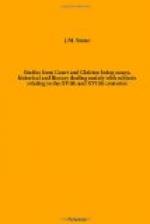The kingdom of Northumbria extended at its most flourishing period as far north as Edinburgh, so named after the great Northumbrian King, Edwin, its southern limit being, as its name implied, the river Humber. Thus, the Ruthwell Cross in Dumfriesshire, and the Bewcastle Cross in Cumberland, belonged alike to Anglia; for although Dumfries formed part of the kingdom of Strathclyde, the territory to the east of Nithsdale was generally reckoned a part of Northumbria, and if we were less hampered by our modern geographical limits and boundaries, we should better realise that the land north and south of the Tweed was one and the same country, without distinction of race or language. And as if in solemn protest of the political barriers, which were set up in the course of ages, these two obelisks, the one now in Scotland, the other in England, continue to point heavenwards, each bearing upon their faces the same grand old Northumbrian language, which is the mother-tongue of all English speaking people.
Both crosses have been, down to the present day, the subject of much diversity of opinion among antiquaries, first with regard to their respective ages, and secondly as to the authorship of the inscriptions on the Ruthwell Cross. The celebrated Danish antiquary, Dr. Muller, considered that the Ruthwell Cross could not be older than the year 1000, and he arrived at this conclusion by a study of the ornamentation, which he placed as late as the Carlovingian period, the style having been imported from France into England. Muller, however, though a good archaeologist, was not a runic scholar, and Professor George Stephens maintained* that not ornamentation merely, but a variety of other things must also be taken into consideration, and that these are often absolute and final, so that sometimes the object itself must date the ornamentation. Then Dr. Haigh, who had passed his life in the study of the oldest sculptured and inscribed stones of Great Britain and Ireland, stepped in and pronounced “this monument (the Ruthwell Cross) and that of Bewcastle to be of the same age and the work of the same hand; and the latter must have been erected A.D. 664-5."*
* Old Northern Runic Monuments, Afterwrit, p. 431,
He was led to this conclusion not by the ornamentation, but rather in spite of it; and in consideration of the runic inscriptions, which he declared had not only passed out of date on funeral monuments as late as the year 1000, but as he read the name of Alcfrid on the Bewcastle Cross, he inferred both that and the Ruthwell Cross to be productions of the latter half of the seventh century. The inscription, of which we will treat more particularly later on, is to the effect that the obelisk was raised to the memory of Alcfrid, son of that King of Northumbria, who decided to celebrate Easter according to the Roman precept. Alcfrid died about the year 664, and thus when we consider the similarity of the ornamentation, and the character of the runes on both obelisks, there seemed good reason for the above inference.




